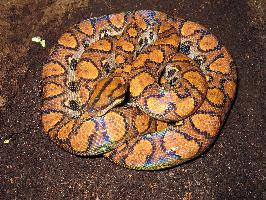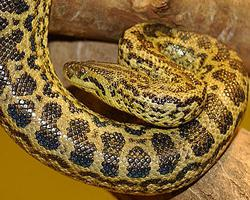
Váhy a míry
| Délka | od 140 do 180 cm |
|---|
Popis zvířete
The Angolan python (Python anchietae) is a captivating species of non-venomous snake indigenous to the arid and semi-arid regions of southwestern Africa, specifically thriving in countries such as Angola and Namibia. This species, named in honor of the Portuguese naturalist José Alberto de Oliveira Anchieta, stands out for its unique physical characteristics and relatively docile nature, making it an intriguing subject of study for herpetologists and a prized species among exotic pet enthusiasts.Typically, Angolan pythons exhibit a moderate size compared to other pythons, with adults generally reaching lengths of 4 to 6 feet (about 1.2 to 1.8 meters). This species is characterized by a robust and muscular body, a short tail, and a distinctively small, rounded head that is somewhat disproportionate to its girthy body. Their scales are smooth and glossy, contributing to their striking appearance. One of the most remarkable features of the Angolan python is its pattern and coloration. The base color of these snakes ranges from a light brown to a reddish-brown, overlaid with irregularly shaped darker brown to blackish patches. These patches are often bordered by a creamy-white or yellowish color, creating a beautiful and distinctive contrast that enhances their visual appeal.
The skin of the Angolan python is notably thicker and tougher than that of many other python species, an adaptation believed to protect the snake from the rough, rocky environments it inhabits. Additionally, unlike the more common Ball python (Python regius) with which it is sometimes compared, the Angolan python possesses beaded scales that give it a unique, granular texture.
Angolan pythons are primarily terrestrial creatures, though they exhibit some climbing abilities in their natural habitat. They are known for their secretive and reclusive nature, spending much of their time hidden within rock crevices, underground burrows, or within dense brush to escape the harsh desert heat and to ambush prey. Their diet primarily consists of small mammals such as rodents, but can also include birds and other small animals.
When it comes to reproduction, Angolan pythons are oviparous, meaning they lay eggs. Females typically lay a clutch of 8 to 12 eggs, which they incubate through a process known as "shivering thermogenesis" where they contract their muscles to generate heat to maintain the optimal temperature for embryo development. The eggs hatch after approximately 90 days, revealing relatively large and independent hatchlings.
Despite their fascinating nature, Angolan pythons face threats from habitat loss due to human activities and the pet trade. While they are not currently listed as endangered, their populations are under observation to ensure that they remain stable. Conservation efforts and responsible pet ownership are crucial to safeguarding the future of this unique species.
In summary, the Angolan python is a remarkable and beautiful snake, distinguished by its robust build, distinctive beaded scales, and striking color pattern. Its adaptation to the arid environments of southwestern Africa, combined with its elusive nature, make it a fascinating subject of study and a unique companion for those dedicated to its care in captivity.
Podobná zvířata
Nové fotografie zvířat
Top 10 zvířat
- Dolphin gull (Leucophaeus scoresbii)
- Stone loach (Barbatula barbatula)
- Diana monkey (Cercopithecus diana)
- Japanese macaque (Macaca fuscata)
- Greek tortoise (Testudo graeca)
- Galápagos tortoise (Geochelone nigra complex)
- Russian tortoise (Testudo horsfieldii)
- Moustached guenon (Cercopithecus cephus)
- Galápagos penguin (Spheniscus mendiculus)
- Common flying dragon (Draco volans)


